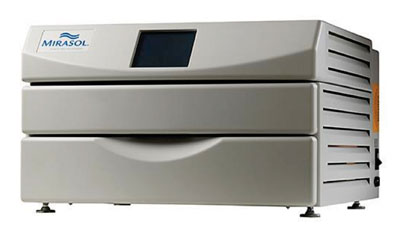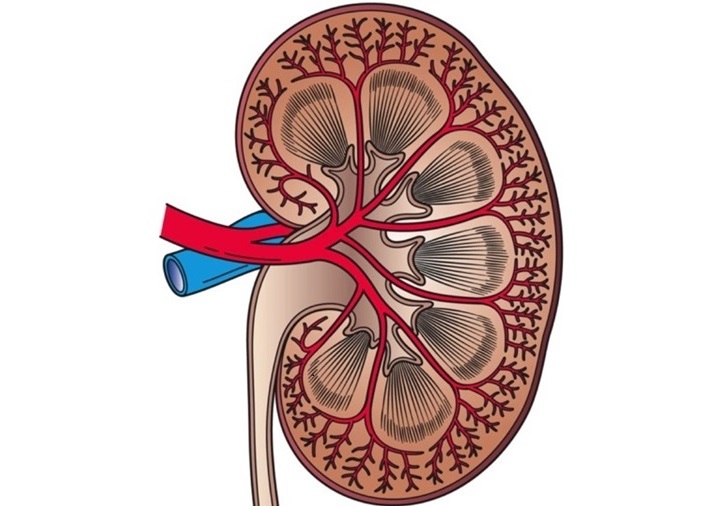Blood Transfusions in Malaria Zones Made Safer
|
By LabMedica International staff writers Posted on 03 May 2016 |

Image: The Mirasol pathogen reduction technology for blood transfusions (Photo courtesy of Terumo BCT).
Patients, especially children, who undergo blood transfusions in sub-Saharan Africa, are at high risk of transfusion-transmitted malaria. Every year, approximately 214 million people worldwide are infected with acute malaria, the majority of whom are in Africa and the disease is caused by the parasite Plasmodium.
A new trial suggests that treating donated blood with a new technology that combines ultra-violet (UV) radiation and vitamin B is safe and could minimize the risk of malaria infection following blood transfusions. Commonly used procedures for whole blood include nucleic acid testing, blood filtration or bacterial culture, but these are not done in most developing countries because of a lack of resources.
Scientists at the University of Cambridge (UK) and their colleagues carried out a randomized, double-blind, parallel-group clinical trial of eligible adult patients, aged 18 years or more, with blood group O+, who required up to two whole blood unit transfusions within three days of randomization and were anticipated to remain in hospital for at least three consecutive days after initial transfusion. There were 223 adult patients who needed a blood transfusion because of severe anemia or hemorrhage took part in the study.
The team analyzed blood samples for all of the transfusion recipients on the day of the transfusion and 1, 3, 7 and 28 days later. By studying the sequences of Plasmodium genes present in the blood, they were able to tell whether the patients were likely to be carrying the donor parasite after the transfusion. A total of 65 patients were not previously carrying the parasite, half received parasite treated blood, and the other half received parasite untreated blood. There were 8/37 patients (22%) who received untreated blood later tested positive for malaria parasite, compared 1/28 (4%) of patients who received treated blood.
Treatment of whole blood was with the Mirasol Pathogen Reduction Technology (Terumo BCT, Lakewood, CO, USA). Coagulation parameters, platelet counts and hemostatic status of the patients was similar whether patients received treated or untreated blood. The technology did not appear to affect the coagulation properties of the blood, and patients who received the treated blood had slightly fewer allergic reactions to those who received the untreated blood (5% versus 8%).
Jean-Pierre Allain, MD, a professor and lead author of the study said, “Testing for parasites such as malaria is expensive and until now, there have been no technologies capable of treating whole blood, which is most commonly used in transfusions in sub-Saharan Africa. This is the first study to look at the potential of pathogen-reduction technology in a real-world treatment setting and finds that although the risk of malaria transmission is not completely eliminated, the risk is severely reduced.” The study was published on the April 21, 2016, in the journal the Lancet.
Related Links:
University of Cambridge
Terumo BCT
A new trial suggests that treating donated blood with a new technology that combines ultra-violet (UV) radiation and vitamin B is safe and could minimize the risk of malaria infection following blood transfusions. Commonly used procedures for whole blood include nucleic acid testing, blood filtration or bacterial culture, but these are not done in most developing countries because of a lack of resources.
Scientists at the University of Cambridge (UK) and their colleagues carried out a randomized, double-blind, parallel-group clinical trial of eligible adult patients, aged 18 years or more, with blood group O+, who required up to two whole blood unit transfusions within three days of randomization and were anticipated to remain in hospital for at least three consecutive days after initial transfusion. There were 223 adult patients who needed a blood transfusion because of severe anemia or hemorrhage took part in the study.
The team analyzed blood samples for all of the transfusion recipients on the day of the transfusion and 1, 3, 7 and 28 days later. By studying the sequences of Plasmodium genes present in the blood, they were able to tell whether the patients were likely to be carrying the donor parasite after the transfusion. A total of 65 patients were not previously carrying the parasite, half received parasite treated blood, and the other half received parasite untreated blood. There were 8/37 patients (22%) who received untreated blood later tested positive for malaria parasite, compared 1/28 (4%) of patients who received treated blood.
Treatment of whole blood was with the Mirasol Pathogen Reduction Technology (Terumo BCT, Lakewood, CO, USA). Coagulation parameters, platelet counts and hemostatic status of the patients was similar whether patients received treated or untreated blood. The technology did not appear to affect the coagulation properties of the blood, and patients who received the treated blood had slightly fewer allergic reactions to those who received the untreated blood (5% versus 8%).
Jean-Pierre Allain, MD, a professor and lead author of the study said, “Testing for parasites such as malaria is expensive and until now, there have been no technologies capable of treating whole blood, which is most commonly used in transfusions in sub-Saharan Africa. This is the first study to look at the potential of pathogen-reduction technology in a real-world treatment setting and finds that although the risk of malaria transmission is not completely eliminated, the risk is severely reduced.” The study was published on the April 21, 2016, in the journal the Lancet.
Related Links:
University of Cambridge
Terumo BCT
Latest Microbiology News
- High-Accuracy Bedside Test to Diagnose Periprosthetic Joint Infection in Five Minutes
- Innovative Diagnostic Approach for Bacterial Infections to Enable Faster and Effective Treatment
- Non-Invasive Stool Test to Diagnose Endometriosis and Help Reduce Disease Progression
- Automated Positive Blood Culture Sample Preparation Platform Designed to Fight Against Sepsis and AMR
- Revolutionary Molecular Culture ID Technology to Transform Bacterial Diagnostics
- New Digital PCR Assays Enable Accurate and Sensitive Detection of Critical Pathogens
- Rapid Diagnostic System to Deliver Same-Shift Antibiotic Susceptibility Test Results
- AST System Delivers Actionable Results for Gram-Negative Bacteria Directly from Positive Blood Cultures
- Ultra-Rapid Culture-Free Sepsis Test Reduces Testing Time from Days to Hours
- New Rapid Method for Determining Virus Infectivity Could Revolutionize Response to Future Pandemics
- Novel Molecular Test to Help Prevent and Control Multi Drug-Resistant Fungal Pathogen in Healthcare Settings
- Innovative C. Difficile Diagnostic Test Provides Both GDH and Toxin Results within 30 Minutes
- Rapid UTI Test Cuts Detection Time from 3 days to 45 Minutes
- POC STI Test Shortens Time from ED Arrival to Test Results
- Integrated Solution Ushers New Era of Automated Tuberculosis Testing
- Automated Sepsis Test System Enables Rapid Diagnosis for Patients with Severe Bloodstream Infections
Channels
Clinical Chemistry
view channel.jpg)
POC Saliva Testing Device Predicts Heart Failure in 15 Minutes
Heart failure is a serious condition where the heart muscle is unable to pump sufficient oxygen-rich blood throughout the body. It ranks as a major cause of death globally and is particularly fatal for... Read more
Screening Tool Detects Multiple Health Conditions from Single Blood Drop
Infrared spectroscopy, a method using infrared light to study the molecular composition of substances, has been a foundational tool in chemistry for decades, functioning similarly to a molecular fingerprinting... Read more
Integrated Chemistry and Immunoassay Analyzer with Extensive Assay Menu Offers Flexibility, Scalability and Data Commutability
As global healthcare systems increasingly shift towards networked laboratory operational models to enhance efficiency and patient access, there is a greater need for innovative solutions tailored to the... Read moreMolecular Diagnostics
view channel
cfDNA Testing Reduces Pregnancy Risks
The highly anticipated emergence of "precision medicine" promises customized technologies that can benefit individuals while potentially lowering healthcare costs. Now, new research suggests that pregnancy... Read more
Non-Invasive Biosensor Facilitates Early Kidney Disease Detection
Traditionally, kidney function has been assessed by measuring blood creatinine levels, which reflect muscle breakdown. Elevated creatinine levels may indicate that the kidneys are not effectively filtering waste.... Read moreImmunology
view channel.jpg)
Advanced Imaging Method Maps Immune Cell Connections to Predict Cancer Patients Survival
A growing tumor is influenced not only by the tumor cells themselves but also by the surrounding tissue, which alters its biology. Immune cells communicate by transferring vital signaling proteins to their... Read more
Computational Tool Predicts Immunotherapy Outcomes for Metastatic Breast Cancer Patients
Immunotherapy aims to enhance the body’s immune response to target cancer cells, but not all patients experience a positive reaction to such treatments. Identifying which patients will benefit from immunotherapy... Read more
Biomarker Could Predict Immunotherapy Response in Liver Cancer
Until recently, patients diagnosed with hepatocellular carcinoma had limited treatment options, with existing therapies extending life by only a few months. Immunotherapy has emerged as a new alternative... Read more
Epigenetic Test Could Determine Efficacy of New Immunotherapy Treatments Against Multiple Myeloma
Multiple myeloma is a blood cancer that primarily affects individuals over the age of sixty, and its occurrence rises as the population ages. In this disease, the bone marrow—the spongy tissue inside bones... Read moreMicrobiology
view channel
High-Accuracy Bedside Test to Diagnose Periprosthetic Joint Infection in Five Minutes
Periprosthetic joint infection (PJI) represents a significant global issue that is worsening as the number of joint replacements increases due to aging populations. In the United States alone, the anticipated... Read more_1.jpg)
Innovative Diagnostic Approach for Bacterial Infections to Enable Faster and Effective Treatment
For patients with bacterial infections, timely treatment with the appropriate antibiotics significantly improves their chances of recovery. Current methods for identifying which antibiotics will be effective... Read more
Non-Invasive Stool Test to Diagnose Endometriosis and Help Reduce Disease Progression
Endometriosis, a painful condition impacting nearly 200 million women globally, occurs when tissue similar to the lining of the uterus grows outside its usual location, such as on the intestines or the... Read more
Automated Positive Blood Culture Sample Preparation Platform Designed to Fight Against Sepsis and AMR
Delayed administration of antibiotics to patients with bloodstream infections significantly increases the risk of morbidity and mortality. For optimal therapeutic outcomes, it is crucial to rapidly identify... Read morePathology
view channel
AI Tool Uses Imaging Data to Detect Less Frequent GI Diseases
Artificial intelligence (AI) is already being utilized in various medical fields, demonstrating significant potential in aiding doctors in diagnosing diseases through imaging data. However, training AI... Read moreAI-Based Method Shows Promise for Pathological Diagnosis of Hereditary Kidney Diseases
Alport syndrome is a hereditary kidney disorder characterized by kidney dysfunction, sensorineural hearing loss, and ocular abnormalities. Early in the disease, patients experience hematuria, which is... Read moreTechnology
view channel
New Noninvasive Methods Detect Lead Exposure Faster, Easier and More Accurately at POC
Exposure to lead can negatively affect health in multiple ways, leading to damage in the brain and central nervous system, delays in development and growth, learning and behavioral issues, problems with... Read more
Noninvasive Test Detects Malaria Without Blood Sample
Malaria remains a significant global health issue, with approximately 250 million cases and over 600,000 deaths reported annually. Nearly half of the world's population is at risk for malaria infection,... Read moreIndustry
view channel
Microbiologics Acquires Diagnostic Quality Controls Manufacturer SensID
Microbiologics (St. Cloud, MN, USA), a biotechnology company specializing in infectious disease reference materials and contract research services, has acquired SensID (Rostock, Germany), a manufacturer... Read more


















_1.jpg)
